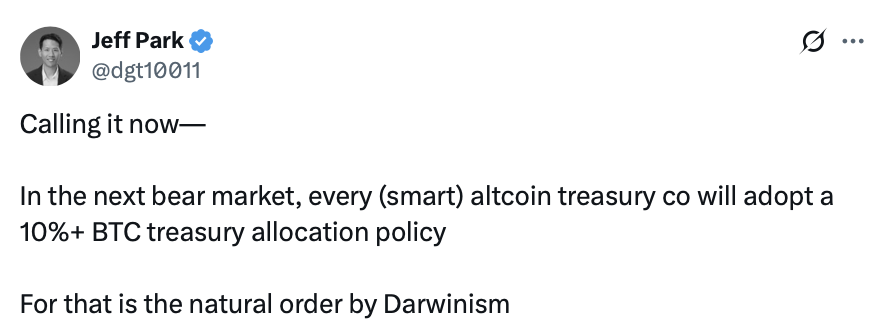Nakamoto CEO David Bailey warns that the “treasury company” label is misleading as many firms add underperforming altcoins to corporate treasuries, muddying the Bitcoin treasury narrative and testing which treasury companies can responsibly build and monetize balance sheets for long‑term value.
-
Key point 1: “Treasury company” label confusion
-
Key point 2: Firms adding altcoins risk trading at a discount if balance-sheet strategies fail.
-
Key point 3: Public Bitcoin holdings ≈ $117.91B; ~3.14% of Ether supply held by listed treasuries.
treasury companies warning: Nakamoto CEO David Bailey says the label is muddled amid altcoin treasuries — read analysis and key takeaways. Learn what this means for BTC treasuries.
Nakamoto CEO David Bailey says the digital asset treasury company “moniker itself is confusing” amid growing interest in balance sheet holdings beyond Bitcoin.
Companies adding underperforming altcoins to their balance sheets are muddying the broader treasury narrative, Bitcoin treasury company Nakamoto CEO, David Bailey, says.
“The treasury company moniker itself is confusing,” Bailey said in an X post on Sunday.
“Toxic financing, failed altcoins rebranded as DATs, too many failed companies with no plan or vision. It’s totally muddled the narrative,” Bailey said.
What did David Bailey say about the state of treasury companies?
David Bailey said the sector is being tested because many firms are expanding treasuries beyond Bitcoin into narrative-driven altcoins, which can erode shareholder value if executed poorly. His view: the core strategy must be to build and monetize your balance sheet, or risk trading at a persistent discount.
Why is the “treasury company” label confusing?
Bailey argues the label conflates different business models. Some public firms simply hold BTC as reserve assets; others pursue higher-risk strategies with altcoins. That mix creates market confusion and inconsistent valuation frameworks for investors.
How are firms expanding treasuries beyond Bitcoin and why does it matter?
Public companies are increasingly exploring Ether (ETH), Solana (SOL), XRP, BNB and other tokens as treasury assets. Firms cite staking yield and narrative-driven theses as drivers. This expansion matters because altcoin exposure introduces liquidity, governance, and counterparty risks that differ from Bitcoin’s store-of-value profile.

Source: Jeff Park
Bailey emphasized that “the core strategy is to build and monetize your balance sheet.”
“If you can do it well, you will grow your assets over time; if you do it poorly, you will trade at a discount and be consumed by someone who can do it better,” he said.
“The bitcoin treasury company of the fiat system is a bank. Today we are building Bitcoin Banks. If you’re afraid of that term, call them Bitcoin financial institutions.”
When did this trend accelerate and which firms are involved?
Interest accelerated in mid‑2025 as publicly-listed entities signaled appetite for broader crypto exposure. Nasdaq-listed Mill City Ventures III was reported to consider raising additional capital to fund a Sui treasury strategy, reflecting growing institutional experimentation with non‑BTC assets.
Narrative-driven theses are driving firms to expand their treasuries beyond Bitcoin, according to industry reports. Ether, Solana, XRP, BNB, and HyperLiquid have gained traction as firms seek yield and diversification.
Bitcoin held in publicly-traded companies is approximately $117.91 billion at the time of publication, per BitcoinTreasuries.NET (reported as plain text).
Ether is gaining traction as an alternative because it can also be staked for annual returns, making it both a store of value and a source of income. Approximately 3.14% of Ether’s total supply is held in publicly-listed treasury companies, per StrategicETHReserve (reported as plain text).
Could expanding treasury allocations explain Bitcoin’s price consolidation?
Galaxy Digital CEO Mike Novogratz suggested treasury companies buying altcoins may contribute to Bitcoin’s sideways price action by redirecting demand into other tokens. Diversified treasury flows can reduce marginal buying pressure for BTC and create short-term price dynamics across the market.
While altcoins in treasuries face scrutiny, concerns also exist for pure Bitcoin treasuries. Venture firm Breed warned that only a subset of Bitcoin treasury companies will avoid severe valuation pressure if they fail to execute long-term balance‑sheet strategies.
Frequently Asked Questions
What defines a treasury company in crypto?
A treasury company is a publicly-listed firm that holds digital assets on its balance sheet to preserve value or generate returns. Definitions vary by strategy: some focus on Bitcoin as a reserve asset; others include staking and altcoin exposure as active treasury management.
How can investors evaluate treasury company risk?
Assess token composition, staking and custody practices, transparency of holdings, and governance. Check audited disclosures and management commentary. Quantify liquidity risk and potential valuation discounts relative to net asset value.
Key Takeaways
- Treasury label confusion: The term “treasury company” now covers diverse strategies, causing investor uncertainty.
- Risk vs reward: Altcoin exposure can offer yield but increases liquidity and valuation risks versus BTC.
- Action for investors: Prioritize transparency, audited disclosures, and clear balance‑sheet monetization plans when evaluating treasury companies.
Conclusion
David Bailey’s warning highlights a turning point: the treasury company concept must evolve with clearer strategy and governance. For investors and corporate managers, the priority is transparent, monetizable balance‑sheet design that protects shareholder value. Watch disclosures and NAV metrics closely as the sector is tested in the months ahead.





